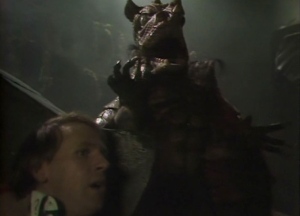Davison’s run of episodes is the shortest so far. Even though he had three seasons plus a special (roughly what Hartnell and Troughton both had), each season has been shorter since the show went to colour, which means, in terms of episodes, Davison’s time on the show feels remarkably short-lived!
Not much has really changed since the latter half of Tom Baker’s stories. The show still flirts with science, mythology, humour and darkness. There are still scary monsters, disturbing imagery and a fair dose of silliness. There are still over-the-top villains, good and bad theatrical performances and action scenes that range from competent to absolutely dreadful. Peter Davison takes on a more action-heavy role, but it hasn’t really changed very much overall.
The show has begun to indulge in its own history a bit more, but this was in part due to the anniversary year. Season 20 and the anniversary special contain a lot of fun throwbacks and some good stories too. Season 21 is rather poor until it picks up at the end. Overall, the range of stories in these three seasons is quite mixed, with some more lighthearted adventures than usual sprinkled throughout.
The Doctor’s companions don’t change much over his shorter run. He almost always has a group, as that seems to be how he works best. Tegan is with him for almost the entire time (having joined shortly before his regeneration, and left shortly before the next one!). Nyssa and Adric are bland and awful respectively. The arrival of Turlough is intriguing and he becomes very entertaining and over-the-top. Kamelion might as well have not been there at all, appearing all but twice. And Peri has only really just settled in, but she makes quite an entrance. Then there’s the younger model, the new Doctor himself…
Thoughts on the Fifth Doctor
If Tom Baker was your mad uncle, Peter Davison is your favourite school teacher. On the whole, he’s a friendly type, but if you step out of line, he will not hesitate to scold you for it. The fifth Doctor is very much an adventurer, with all the same curiosities inherited from his previous incarnations, but with the energy of youth within him too, who wants nothing more than to share the wonders of the universe with his “students”.
He’s wise beyond his years, naturally, but at times he is pushed to physical violence and aggression. I think it’s fair to say that Davison has had a mixed time as the Doctor, but when he’s written well, he can really pull off a good range. As he’s often written into situations where he is virtually powerless, he does handle desperation and panic well. He’s not an eccentric like Baker or Troughton’s versions, but he has some funny lines or quirks. More than once he’s done that thing where he tosses a coin to choose a direction, but tosses it again anyway to get the outcome he wanted.
Mostly, Davison’s Doctor is just a “nice guy”. It’s difficult to dislike him, but at the same time, it’s tough to say that he has a strong personality either. Coming after Baker, the worst you could say is that he’s a little bit bland. However, he is never a detestable bore or anything less than likeable, so that leaves my order of preference looking something like the below (feel free to disagree, naturally):
Tom Baker > Patrick Troughton > Peter Davison > Jon Pertwee > William Hartnell
Episode Highlights
I haven’t had too much trouble picking out my favourite Davison serials. There aren’t as many to choose from and the good ones are fairly easy to pick out. That said, there are some stories that had potential that was squandered by poor plotting or bad production (such as Earthshock). Likewise, there are those that are glossy and well-made but make very little sense (like Resurrection of the Daleks). My list favours originality, style and good fun. Naturally, I’m open to discussion and I always reserve the right to completely change my mind. Here are my picks:
The Visitation (4 parts)
A standard historical alien invasion, accompanied by a loveable rogue highwayman. Good fun!
Mawdryn Undead (4 parts)
A clever use of time travel, some excellently grotesque creatures and the return of the Brigadier.
Enlightenment (4 parts)
Nicely wraps up the Black Guardian Trilogy and provides a big sci-fi idea in a unique setting.
The Five Doctors (1 special)
Is it cheating to include this? A smorgasbord of nostalgia, the best bits of Doctor Who join forces for a fun romp.
Planet of Fire (4 parts)
Character drama comes through as Turlough leaves and Peri joins. A good story and nicely filmed.
The Caves of Androzani (4 parts)
This dark and sophisticated story pushes Peter Davison to his best performance.



































